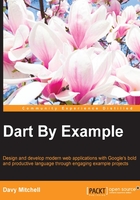
What this book covers
Chapter 1, Starting the Text Editor, will make you familiar with the background of the language, the development tools, and how to run your first Dart application.
Chapter 2, Advancing the Editor, explores classes, data structures, how to build a user interface, and how to use the HTML5 canvas. Furthermore, it looks at how to compile the text editor to JavaScript.
Chapter 3, Slideshow Presentations, covers more advanced class features, such as mixins, string processing, and event handling, while describing how to build a web-based presentation package.
Chapter 4, Language, Motion, and Sound, demonstrates a user interface localization and shows you how to use Dart for animation and sound effects in the presentation package.
Chapter 5, A Blog Server, shows you how to write server-side code in Dart, how to handle a text file, how to serve web pages, and how to deploy on different operating systems. It concludes with benchmarking the server using Dart itself.
Chapter 6, Blog Server Advanced, goes deeper into the server application request processing to populate access logs, file handling, form handling, and security. JSON and XML are covered using Dart packages, as is the powerful asynchronous operation support.
Chapter 7, Live Data Collection, kicks off the largest project in this book, an earthquake monitoring system. Dart will be used to collect real-world JSON data and store it in an industry-standard relational database.
Chapter 8, Live Data and a Web Service, improves the data collection and walks you through how to use Dart to create a RESTful web service. This service is then used to create a live data display using Dart in the web browser.
Chapter 9, A Real-Time Visualization, returns Dart to the client side of HTML5, using a canvas, geolocation, and desktop notifications to create an advanced web application.
Chapter 10, Reports and an API, completes the earthquake system, extending the REST API to handle data input and querying. A Dart reporting website is created, covering data charting and the export feature.